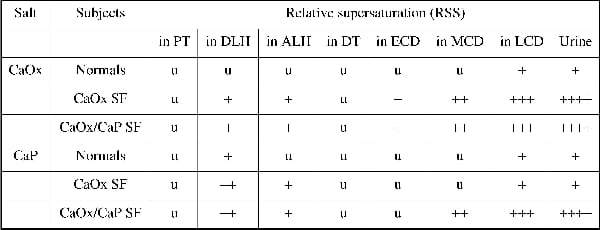The aim of this study was to devise a mathematical model to approximate tubular fluid composition in order to calculate the risk of precipitation of Ca salts in the renal tubule between the glomeruli and ducts of Bellini in the human kidney. A dynamic model of the human kidney was devised to generate tubular fluid composition continuously along the renal tubule. The model included data on pH and the concentrations of Ca, Mg, Na, K, NH4+, P, oxalate (Ox), citrate (Cit), SO42- and uric acid (UA) within tubular fluid. The relative supersaturation (RSS) of Ca salts was calculated at all points along the renal tubule using SUPERSAT [1]. The effect of varying the tubular reabsorption of water and of H+, Ca, P and Ox on RSS was evaluated. In a pilot study, plasma and renal conditions were constructed to yield average urine compositions produced by normal subjects (N) (vol 1.5 litre, pH 5.94, (in mmol/day) Ca 5.4, Mg 4.4, Na 189, K 58, NH4+ 23, P 20, Ox 0.33, Cit 2.6, SO42- 16 and UA 3.2), recurrent CaOx stone-formers (SF) (vol 1.4 litre, pH 5.94, Ca 8.4, Mg 3.8, Na 189, K 58, NH4+ 23, P 29, Ox 0.67, Cit 1.5, SO42- 16 and UA 4.5) and recurrent mixed CaOx/CaP SF (vol 1.4 litre, pH 6.55, Ca 8.4, Mg 3.8, Na 189, K 58, NH4+ 23, P 29, Ox 0.67, Cit 1.5, SO42- 16 and UA 4.5) [2]. A summary of the RSS values of CaOx and CaP at different points along the renal tubule of N and SF is shown in Table 1. In N, tubular fluid is undersaturated with both CaOx and CaP throughout most of the renal tubule becoming only slightly supersaturated in the loop of Henle and in the late collecting duct. In recurrent Ca SF, it is mildly supersaturated with CaOx in the loop and becomes increasingly supersaturated through the CD. In addition, urine from SF is moderately supersaturated with CaP in the loop and increasingly supersaturated through the CD, particularly in the patients with mixed CaOx/CaP stones. The model provides a useful tool (a) to predict the risk of crystallisation at all points along the renal tubule, (b) to correlate with patterns of stone-formation and nephrocalcinosis observed in vivo and (c) to understand better the underlying pathophysiology of nephrolithiasis.
University College London 2006 (2006) Proc Physiol Soc 3, PC21
Poster Communications: A mathematical model for calculating the risk of crystallisation of calcium salts in the renal tubule
William G Robertson1, Philippe Jaeger2, Robert J Unwin2
1. Institute of Urology and Nephrology, University College London, London, United Kingdom. 2. Centre for Nephrology, Royal Free Hospital, London, United Kingdom.
View other abstracts by:
Table 1. RSS values
Where applicable, experiments conform with Society ethical requirements.

